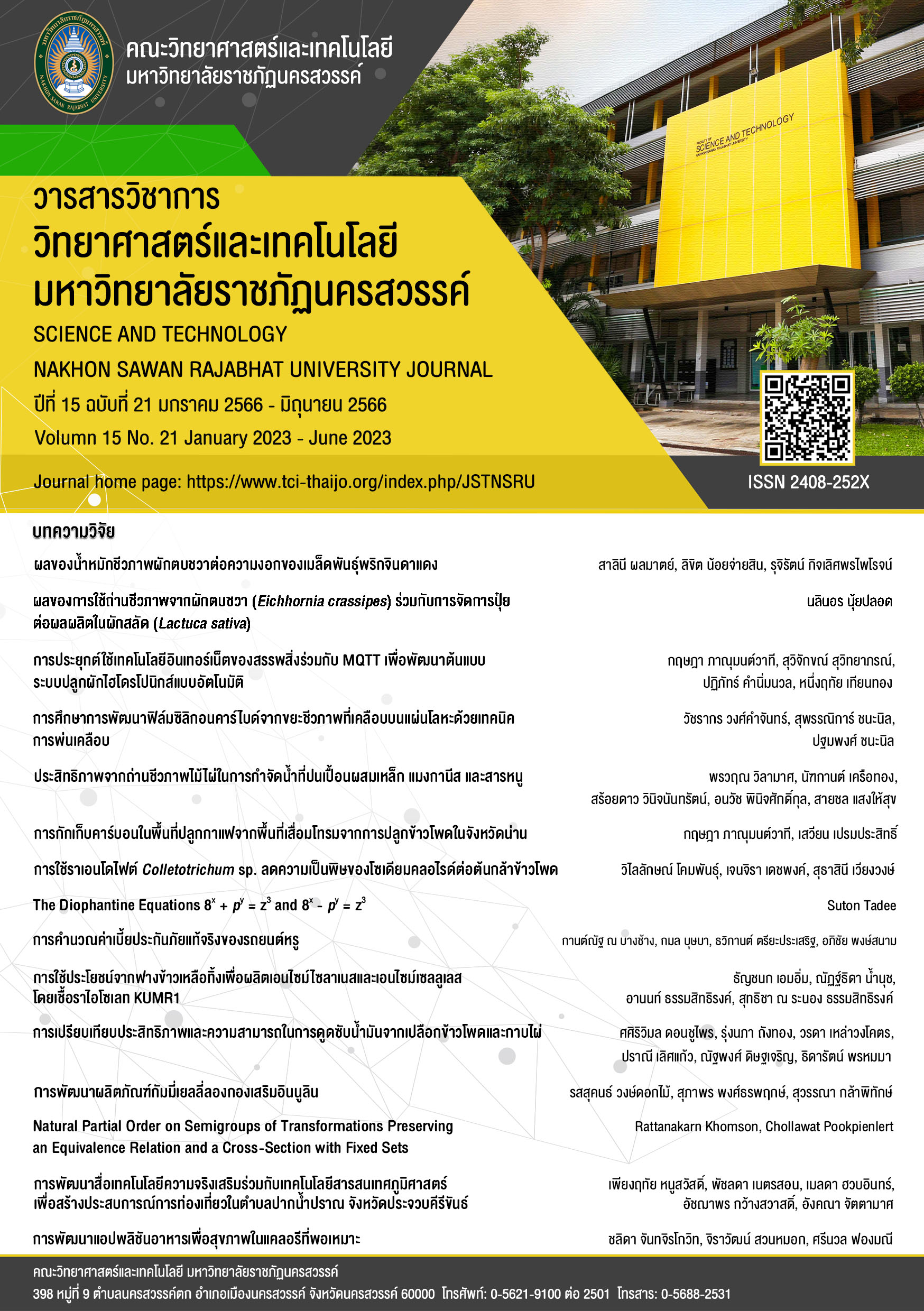ประสิทธิภาพจากถ่านชีวภาพไม้ไผ่ในการกำจัดน้ำที่ปนเปื้อนผสมเหล็ก แมงกานีส และสารหนู
Main Article Content
Abstract
งานวิจัยนี้มีวัตถุประสงค์เพื่อศึกษาการปนเปื้อนปริมาณเหล็ก แมงกานีส และสารหนู ในแหล่งน้ำใกล้พื้นที่เหมืองแร่ทองคำในจังหวัดพิจิตร และศึกษาความสามารถในการดูดซับโลหะหนักชนิดเดียวและโลหะผสมในน้ำสังเคราะห์ด้วยถ่านชีวภาพไม้ไผ่ ถ่านชีวภาพไม้ไผ่ที่เคลือบไคโตซาน และถ่านชีวภาพไม้ไผ่ฝังเหล็ก ศึกษาองค์ประกอบทางเคมี ความเป็นกรดด่าง และไอโอดีนนัมเบอร์ ศึกษาประสิทธิภาพการดูดซับด้วยการหาระยะเวลาสมดุลของการดูดซับ และความเข้มข้นของโลหะหนักที่เหลือที่ระยะเวลาสมดุล จากนั้นทำศึกษาการนำถ่านชีวภาพไม้ไผ่กลับมาใช้ซ้ำเพื่อดูดซับโลหะหนักผสม ผลการวิเคราะห์พบปริมาณเหล็กสูงในน้ำผิวดินและน้ำบาดาลมีปริมาณแมงกานีสสูงกว่าเกณฑ์คุณภาพน้ำดื่ม ขึ้นกับสภาพทางธรณีวิทยาของพื้นที่ องค์ประกอบของถ่านชีวภาพไม้ไผ่มีเหล็กและแมงกานีสร้อยละ 6.83 และ 2.37 ตามลำดับ การเคลือบไคโตซานทำให้องค์ประกอบของเหล็กและแมงกานีสลดลง และการฝังเหล็กทำให้สัดส่วนของเหล็กและซิลิกาเพิ่มขึ้น ถ่านชีวภาพไม้ไผ่ ให้ค่าความเป็นกรดด่างเป็นกลางถึงด่าง ส่วนถ่านเคลือบไคโตซานและฝังเหล็กให้ค่าเป็นกรด ค่าไอโอดีน นัมเบอร์ถ่านชีวภาพไม้ไผ่มีค่าสูงสุดเท่ากับ 75.30 มิลลิกรัม/กรัม ระยะเวลาสมดุลของการดูดซับเหล็กเกิดขึ้นได้ในเวลา 24 ชั่วโมง ส่วนการดูดซับแมงกานีสด้วยถ่านชีวภาพไม้ไผ่ถึงระยะเวลาสมดุลการดูดซับเร็วกว่าถ่านที่ปรับปรุงพื้นผิว และการดูดซับสารหนูด้วยถ่านฝังเหล็กมีระยะเวลาสมดุลที่ 2 ชั่วโมง การปรับปรุงพื้นผิวถ่านชีวภาพไม้ไผ่เหมาะกับการบำบัดโลหะหนักชนิดเดียว ถ่านชีวภาพไม้ไผ่ที่ดูดซับเหล็กและแมงกานีสแล้วเมื่อนำกลับมาใช้ใหม่เพื่อดูดซับโลหะหนักผสม สามารถบำบัดได้เพียงเหล็กและสารหนู ดังนั้นถ่านชีวภาพไม้ไผ่จึงเหมาะสมที่จะนำไปใช้เป็นวัสดุกรองน้ำ
Article Details

This work is licensed under a Creative Commons Attribution-NonCommercial-NoDerivatives 4.0 International License.
References
กรมทรัพยากรน้ำบาดาล. (2563). สรุปรายงานสถานการณ์น้ำบาดาลประเทศไทยประจำปี พ.ศ. 2563. สำนักอนุรักษ์และฟื้นฟูทรัพยากรน้ำบาดาล. http://www.dgr.go.th/th/public-service/329
กรมอนามัย. (2563). เกณฑ์คุณภาพน้ำประปาดื่มได้. ประกาศกรมอนามัย เรื่อง เกณฑ์คุณภาพน้ำประปาดื่มได้ กรมอนามัย พ.ศ. 2563, กองสุขาภิบาลอาหารและน้ำ: กรมอนามัย: กระทรวงสาธารณสุข.
ธัญพิสิษฐ์ พวงจิก. (2558). ถ่านกัมมันต์จากไม้ไผ่ : ตลาดยังมีความต้องการสูง ?. วารสารวิทยาศาสตร์และเทคโนโลยี, 23(6), 945-956. https://li01.tci-thaijo.org/index.php/tstj/article/download/41333/34163/94922
ประกาศกระทรวงทรัพยากรธรรมชาติและสิ่งแวดล้อม (2559). ราชกิจจานุเบกษา, 125(ตอนพิเศษ 85 ง), 110-111.
Alaya, M.N., Hourieh, M.A., Youssef, A.M., & El-Sejariah, F. (2000). Adsorption properties of activated carbons prepared from olive stones by chemical and physical activation. Adsorption Science & Technology 18(1), 27-42. https://doi.org/10.1260/0263617001493251
Albarelli, J.Q., Luna, M.T., Vieira, R.S., & Beppu, M.M. (2012). Evaluation of glass beads coated with chitosan for the adsorption of copper (II) ions from aqueous solution. Adsorption Science & Technology, 30(3), 227-240. https://doi.org/10.1260/0263-6174.30.3.227
Al-Degs, Y., Khraisheh, M.A.M., Allen, S.J., & Ahmad, M.N. (2000). Effect of carbon surface chemistry on the removal of reactive dyes from textile effluent. Water Research, 34(2), 927-935. https://doi.org/10.1016/S0043-1354(99)00200-6
Benefield, L.D., Judkins, J.F., & Weand, B.L. (1981). Process chemistry for water and wastewater treatment. Prentice-Hall: Englewood Cliffs.
Benis, K.Z., Damuchali, A.M., Sotan, J., & McPhedran, K.N. (2020). Treatment of aqueous arsenic-A review of biochar modification methods. Science of the Total Environment, 739(10), 139750. https://doi.org/10.1016/j.scitotenv.2020.139750
Gu, Z., Fang, J., & Deng, B. (2005). Preparation and evaluation of GAC-based iron-coating adsorbents for arsenic removal, Environ Sci Technol, 39(10), 3833-3843. https://doi.org/10.1021/es048179r
Jung, K., Oh, S., Bak, H., Song, G.H., & Kim, H.T. (2019). Adsorption of Arsenic and Lead onto Stone Powder and Chitosan-Coated Stone Powder. Processes, 7(9), 599. https://doi.org/10.3390/pr7090599
Kalaruban, M., Loganathan, P., Nguyen, T.V., Nur, T., Johir, Md. A.H., Nguyen, T.H., & Trinh, M.V. (2019). Iron-impregnated granular activated carbon for arsenic removal: Application to practical column filters. Journal of Environmental Management, 239, 235-243. https://doi.org/10.1016/j.jenvman.2019.03.053
Newcombe, G. Hayes, R., & Drikas, M. (1993). Granular activated carbon: importance of surface properties in the adsorption of naturally occurring organics. Colloids and Surfaces A: Physicochemical and Engineering Aspects, 78, 65-71. https://doi.org/10.1016/0927-7757(93)80311-2
Nomanbhay S.M., Palanisamy K., 2005, Removal of heavy metal from industrial wastewater using chitosan coated oil palm shell charcoal, Electronic Journal of Biotechnology, 8(1). http://www.ejbiotechnology.info/index.php/ejbiotechnology/article/view/v8n1-7/430
Ravenscroft, P., Brammer, H., & Richards, K. (2009). Arsenic pollution A global Synthesis, Wiley-Blackwell. https://doi.org/10.1002/9781444308785
Simoes, M.C., Hughes, K.J., Ingham, D.B., Ma, L., & Pourkashanian, M. (2017). Estimation of the thermochemical radii and ionic volumes off complex ions. Inorganic Chemistry, 56(13), 7566–7573. https://doi.org/10.1021/acs.inorgchem.7b01205
Takeno, N. (2005). Atlas of Eh-pH diagrams-Intercomparison of thermodynamic databases. National Institute of Advanced Industrial Science and Technology, 419, 29-31. https://www.nrc.gov/docs/ML1808/ML18089A638.pdf
Vinitnantharat, S., Rattanasirisophon, W., & Ishibashi, Y. (2007). Modification of granular activated carbon surface by chitosan coating for geosmin removal: sorption performances. Water Science and Technology, 55(5), 145–152. https://doi.org/10.2166/wst.2007.173
Viessman, W. Jr., & Hammer, M. J. (1985). Water supply and pollution control (4th ed.). New York: Harper and Row Publishers.
Zhou, Q., Yang, N., Li, Y., Ren, B., Ding, X., Bian, H., & Yao, X. (2020). Total concentrations and sources of heavy metal pollution in global river and lake water bodies from 1972 to 2017. Global Ecology and Conservation, 29(6), e00925. https://doi.org/10.1016/j.gecco.2020.e00925


